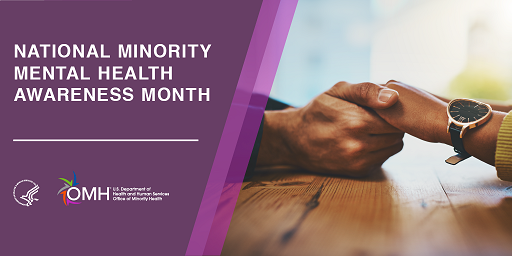July is known as Minority Mental Health Awareness Month and it offers many opportunities to talk about important mental health issues.
The month is sponsored by the U.S. Department of Health & Human Services Office of Minority Health (OMH) which emphasizes health policies and programs that will help eliminate health disparities.
The recent news of elite Olympic athletes prioritizing their mental health and their own physical wellness over their sport has focused a national spotlight on the complexities and the prevalence of mental health struggles. And while seeing people who are suffering from mental health issues is difficult, the athletes’ public struggles have opened a door that allows healthcare providers to raise the issue with patients and loved ones.
In some minority communities, mental health struggles remain taboo to discuss openly. People who are experiencing symptoms of illness such as depression, anxiety, or obsessive-compulsive disorder, or even life-threatening suicidal thoughts face a stigma that prevents them from even seeking care. When the issues are discussed, access to affordable and high-quality mental health providers can be a barrier to getting help, as can lack of insurance and any language barriers.
According to the OMH, mental health is a serious and common health issue with approximately 18 percent of the entire U.S. population having a diagnosable mental illness within any given year. Of that percentage, only 43 percent of people who need mental health care receive treatment or counseling. For minority mental health needs, the numbers are even more concerning. While 48 percent of whites receive care, only 31 percent of Blacks and Hispanics do. And statistics for Asians were even lower at just 22 percent receiving needed mental health services. Disparities in mental health care can lead to lack of treatment or ineffective treatment.
For most people, mental health treatment is effective and improves their quality of life. Whether people choose medication (psychiatric nurse practitioners are especially), talk therapy, or a combination of both, getting help can make symptoms abate significantly. In more transient cases of mental illness, for example depressive symptoms caused by a major life change, treatment can get someone back to feeling like their old selves and can improve their resiliency moving forward.
These care disparities have lasting impact. According to the American Psychiatric Association minority and white populations have similar rates of mental illness, with white populations being slightly higher in some instances. But when Black and Hispanic people have depression, for example, the effects are more persistent. And systemic racism plays a role in proper care. The report states that “Racial/ethnic minority youth with behavioral health issues are more readily referred to the juvenile justice system than to specialty primary care, compared with white youth.” If mental health needs aren’t addressed and youth don’t receive proper care, that can lead to a disciplinary cycle that impedes educational and employment opportunities.
As a healthcare provider, keeping conversations about minority mental health open and ongoing with patients and having easily accessible resources available can make all the difference to helping patients get the care they need. From understanding the different types of mental health professionals and what they do to addressing medications or alternative therapies in a comprehensive treatment approach can help patients understand the range of help available. And with a recent uptick in the availability and acceptance of virtual therapy appointments, accessing care is somewhat easier for people.
Raising awareness and broaching the topic about minority mental health is important to removing the stigma and helping people move toward care that works for them.
- WOC Nurses Week Highlights Specialty - April 16, 2024
- Honoring Radiology Nurses Day on April 12 - April 12, 2024
- Travel Offers New Career Possibilities - April 8, 2024



